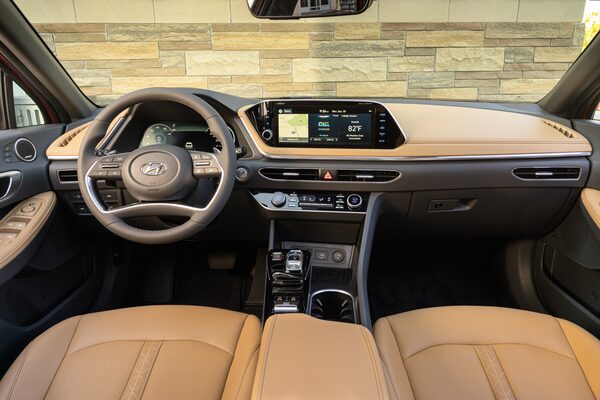
The 2020 Hyundai Sonata.Jeremy Sinek
There’s not much to please the eye in southern Alabama. The landscape is mainly flat and drab. Montgomery, the state capital, appears to be a once-elegant city that is striving to come back from hard times. Out in the sticks, poverty is evident in shabby homes with scruffy beaters in their car ports.
All of which makes the 2020 Hyundai Sonata I’m driving look like the proverbial rose among thorns. We’ve become used to fastback silhouettes on mid-size sedans, but the eighth-generation Sonata seems to carry it off with more grace than most. And then there’s its arresting face. The way the hood extends all the way forward to the top of the grille is unique in its class. As is the way the front fenders fall away at the sides.
Two generations back, Hyundai rocked the mid-size sedan establishment with the bold, sleek shape of the 2011 Sonata. “It was iconic,” says Kevin Kang, a designer from Hyundai’s studio in Irvine, Calif. “It put us on the map.”
Five years later, however, the next-generation Sonata dialled it back – the 2016 redesign was much more conservative.
For the 2020 remake, Hyundai’s goal was simply to craft “the most beautiful mid-size sedan.” The automaker’s South Korean, U.S. and European design centres each submitted a proposal for the new car’s shape, and the Koreans won (although Kang’s U.S. team did the interior).
Kang says the design team had to go head to head with the engineers to get the look they wanted, in particular to get the lower shock towers that would allow the hood to curve down gracefully into the fenders. “Every millimetre, we had to fight to make it happen.”
The outcome is a hood that’s eight millimetres lower at the cowl than before, and more than 60 mm further back. That translates to a longer dash-to-axle ratio, the dimension (a.k.a. “premium gap”) that designers say is critical to an upscale look.

The hood is eight millmetres lower at the cowl than the previous model's, and more than 60 mm further back.Jeremy Sinek
As for our test drive, there’s a reason Hyundai staged the first North American media drive in Alabama: Since 2005, the Sonata, and more recently its Elantra and Santa Fe stable mates, has been built just south of Montgomery.
Coddled in the quiet comfort of the 2020 Sonata, with no challenging roads or dramatic scenery to engage me, I find myself reflecting upon how this drive could (should?) have been taking place in the Eastern Townships of Quebec. You see, Montgomery isn’t Hyundai’s first North American transplant. Three decades ago, the South Korean automaker built a brand-new factory to assemble the first-generation Sonata in Bromont, Que.
Hyundai first entered the North American market in 1984 with the Canadian launch of its made-in-South-Korea Pony subcompact. The car was so cheap, and its arrival so timely (Canada was just emerging from the early-eighties recession) that in only its second year, it became the top-selling car in Canada.

The way the redesigned Sonata's hood extends all the way forward to the top of the grille is unique in its class.Jeremy Sinek
Pumped by that early success, the South Koreans decided to build an assembly plant 80 kilometres east of Montreal in Bromont, a town better known as a resort destination with golf and water sports in summer, and skiing in winter.
Meanwhile in early 1986, Hyundai launched in the United States. As in Canada, sales soared initially, lifted by bargain pricing and a perception that the quality of all Asian cars would be as good as the Japanese.
The perception proved false, however. Consumers Reports rated the reliability of the 1987-91 Excel and the 1989-91 Sonata as “much worse than average” for every model year they were on the market. By the time the Bromont plant was ready to begin building the Sonata in 1989, sales were heading south in both countries. It didn’t help that the Sonata itself was dreary to drive and dull to look at.
In its best year, Bromont built 28,000 Sonatas – far below its 100,000-unit capacity. Production wound down in 1993, and the plant was shuttered the following year. Today, it’s an industrial rental property with tenants that include a cabinet maker and a small startup, Zeal Motor, that builds an industrial off-road utility vehicle.
Even if the original Sonata had been better built, and was as right for its times as the 2020 model is now, we can’t be sure Hyundai would still be building them in Quebec. Bromont is a long way from the supplier base, and there must have been a language barrier for Korean managers whose second language was more likely English than French. In the nineties, there was also the real possibility that Quebec might separate from Canada.
Still, a drive route based in Bromont, with perhaps a loop across the border into the Green Mountains for a lunch stop in Montgomery, Vt., would have provided a more meaningful workout for the 2020 Sonata, as well as some photo locations as pleasing to the eye as the car itself.
The writer was a guest of the automaker. Content was not subject to approval.
Shopping for a new car? Check out the new Globe Drive Build and Price Tool to see the latest discounts, rebates and rates on new cars, trucks and SUVs. Click here to get your price.
Stay on top of all our Drive stories. We have a Drive newsletter covering car reviews, innovative new cars and the ups and downs of everyday driving. Sign up today.